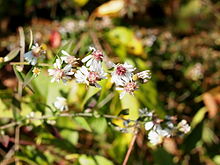Symphyotrichum lateriflorum
| Calico aster | |
|---|---|

| |
| Scientific classification | |
| Kingdom: | Plantae |
| Clade: | Tracheophytes |
| Clade: | Angiosperms |
| Clade: | Eudicots |
| Clade: | Asterids |
| Order: | Asterales |
| Family: | Asteraceae |
| Genus: | Symphyotrichum |
| Species: | S. lateriflorum
|
| Binomial name | |
| Symphyotrichum lateriflorum | |
Symphyotrichum lateriflorum (common name calico aster[1] or starved aster[2]) is a species of flowering plant in the daisy family Asteraceae, native to eastern North America. In the British Isles it is still widely referenced under its old name, Aster lateriflorus syn. A. diffusus, A. vimineus.[3]
Growing to 120 cm (47 in) tall by 30 cm (12 in) wide, S. lateriflorum is a clump-forming herbaceous perennial with alternate, simple leaves on stiff, hairy, purplish stems. Small white or pale lilac composite daisy-like flowers are borne in corymbs up to 15 cm (6 in) across in late summer and fall (autumn).
Like other asters, this plant is valued in gardens for providing late colour after the main flowering season has finished. The cultivar S. lateriflorum var. horizontale[4] has gained the Royal Horticultural Society's Award of Garden Merit.[5]
References
- ^ USDA, NRCS (n.d.). "Symphyotrichum lateriflorum". The PLANTS Database (plants.usda.gov). Greensboro, North Carolina: National Plant Data Team. Retrieved 6 December 2015.
- ^ "BSBI List 2007". Botanical Society of Britain and Ireland. Archived from the original (xls) on 2015-01-25. Retrieved 2014-10-17.
- ^ RHS A-Z encyclopedia of garden plants. United Kingdom: Dorling Kindersley. 2008. p. 1136. ISBN 1405332964.
- ^ "RHS Plant Selector - Aster laterifolius var. horizontalis". Retrieved 17 July 2013.
- ^ "AGM Plants - Ornamental" (PDF). Royal Horticultural Society. July 2017. p. 100. Retrieved 30 November 2018.
